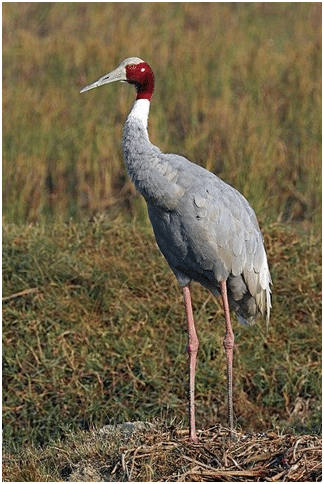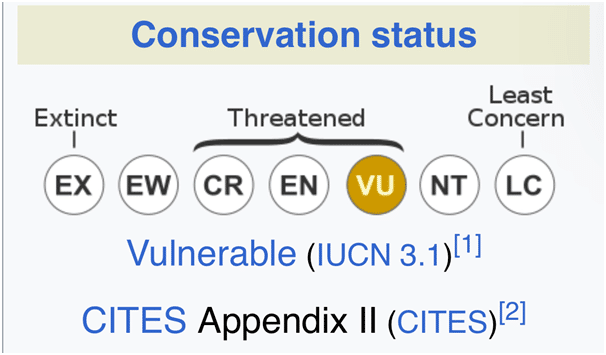Wildlife Protection Act 1972
Context: Recently a UP man was booked under the Wildlife Protection Act, 1972, for “illegally” keeping and nursing an injured Sarus crane (Grus Antigone) he found in his village.The Sarus crane is usually found in wetlands and is the state bird of Uttar Pradesh. Standing at 152-156 centimetres, it is the world’s tallest flying bird.
What is the Wildlife Protection Act?
- The Wildlife Protection Act came into force on September 9, 1972, to provide for the protection of wild animals, birds and plants to ensure the ecological and environmental security of the country.
- It aims to conserve protected species in two main ways:
- firstly, by prohibiting their hunting
- secondly by protecting their habitat through the creation and regulation of sanctuaries, national parks, reserves, etc.
- Further, the Act prohibits capturing or hunting any species of animals listed under Schedules I-IV( 4 in the new Amendment) , barring a few exceptions such as hunting a diseased or dangerous animal or bird constituting a threat to human life or property or for scientific research or management.
- Offences under the Act can be divided into three categories;
- Hunting
- Unauthorised possession, transport, and trade
- Offences related to protected areas or habitat destruction
How is hunting defined under the Act?
- Hunting” under Section 2 (16) of the Act includes not just the act of killing or poisoning a wild or captive animal, but even an attempt to do so.
- Besides, it details capturing, coursing, snaring, trapping, driving or baiting any wild or captive animal and attempts for the same.
- A “captive animal” is defined under the WPA as any animal, specified in Schedule I-IV, which is captured or kept, or bred in captivity.
- Even injuring or destroying any part of the animal or its eggs or nests is an offence punishable under Section 9 of the Act.
What are the penalties for violating the provisions of the WPA?
- Section 51 says that any person who contravenes any provision of the Act, except those on trade, commerce, and taxidermy of certain animals and the prohibition on teasing animals in a zoo having separate penalties, shall be punished with up to three years imprisonment or fine up to Rs. 25,000 rupees or both. This also extends to any rule, order, or breach of conditions of a license or permit.
- However, according to the latest amendment to the 1972 Act enacted on August 2, 2022, which is yet to come into force, the fine was increased to one lakh rupees.
- If the offence relates to animals under the first two Schedules, imprisonment can be between three to seven years, with or without a fine of Rs 10,000, which will increase to Rs. 25,000 after the 2022 Amendment.
- Further, Section 57 says that when during prosecution for an offence under the Act, “it is established that a person is in possession, custody or control of any captive animal” or its article, meat, trophy, uncured trophy, it shall be presumed that he is in “unlawful possession, custody or control” of such animal. The burden of proving otherwise shall lie on the accused.
What are the powers of the state government?
- With the advent of the 42nd Amendment Act, the subject of “Forests and Protection of Wild Animals and Birds” was transferred from State to Concurrent List.
- However, state governments still enjoy a host of powers under the WPA, 1972.
- Section 4 allows the State government to appoint a Chief Wildlife Warden alongside wildlife wardens, honorary wildlife wardens, and other officers and employees.
- In addition, Section 6 empowers the state to constitute a State Board for Wild Life, consisting of the Chief Minister as chairperson, the Minister in charge of Forests and Wildlife as the vice chairperson, and at least three members of the State legislature, among others.
- State governments can also add or delete any entry to or from any Schedule or transfer any entry from one part of a Schedule to another, provided that any such alteration made by the State Government is done with the previous consent of the Centre
- state governments can notify certain rules, including the conditions subject to which any license or permit may be granted or under which the officers will be authorised to file cases in court.
What is the 2022 Amendment to the WPA?
- The WPA Amendment Act which will come into force on 1 April 2023 seeks to implement the provisions of CITES, an international agreement between governments ensuring international trade of wild animals and plant species does not threaten their survival.
- Importantly, the Amendment reduces the number of schedules from 6 to 4, whereby Schedule V, for vermin or animals that destroy food crops, will be done away with.
- The revised Act also accords greater powers to the Centre concerning the export, import, regulation, prohibition, and trade of plant or animal species, through a designated Management Authority.
- Further, the exemption under Section 43 of the 1972 Act was amended to allow for the transfer of elephants for religious and other purposes, including commercial purposes, by a person having a valid certificate of ownership subject to terms and conditions as may be prescribed by the Central Government.
| Practice Question
1. What is the Wildlife Protection Act? What are the penalties for violating the provisions of the WPA?
|





